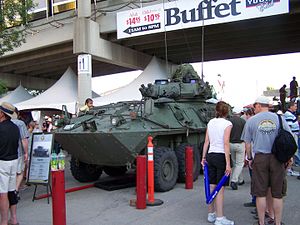Bison and Coyote armoured vehicles
This article needs additional citations for verification. (February 2012) |
| Coyote Reconnaissance Vehicle | |
|---|---|
 Canadian light armoured vehicle at the Calgary Stampede | |
| Type | Armoured fighting vehicle |
| Place of origin | |
| Production history | |
| Designer | General Motors Diesel Division MOWAG |
| Specifications | |
| Mass | 14.4 t (15.9 short tons) |
| Length | 6.39 m (21.0 ft) |
| Width | 2.50 m (8.2 ft) |
| Height | 2.69 m (8.8 ft) |
| Crew | 4 (driver, commander, gunner, surveillance suite operator) |
Main armament | 1 × M242 25mm chain gun |
Secondary armament | 1 × C6 7.62mm machine gun (coaxial) 1 × C6 7.62mm machine gun (pintle) 8 × grenade launchers (2 × cluster of 4) |
| Engine | Detroit Diesel 6V53T 275hp |
| Suspension | 8×8 wheeled, 4× drive |
Operational range | 660 km |
| Maximum speed | 120 km/h |
The Coyote Reconnaissance Vehicle is a lightly armoured fighting vehicle built by General Dynamics Land Systems Canada for the Canadian Forces, for use in the reconnaissance role.[1][2] Its eight-wheeled design is a licensed version of the Swiss MOWAG Piranha 8x8. In service since 1996, the Coyote is a later generation of the six-wheeled Canadian AVGP, also developed from the Piranha. It is of a similar family and similar generation as the, Bison APC, USMC LAV-25 and the Australian ASLAV.
Design
Armament
The Coyotes mount a 25 mm M242 Bushmaster chain gun and two 7.62 mm C6 general purpose machine guns.[1] One of the machine guns is mounted coaxial to the main gun while the other is pintle-mounted in front of the crew commander's hatch. The main gun is equipped with dual ammunition feeds that allow for separate weapons effects, selectable by the gunner/crew commander; the standard load is a belt of armour-piercing sabot rounds and a belt of HE-T explosive/fragmentation rounds. The main gun and coax machine gun are 2-axis stabilized. The turret is equipped with a laser rangefinder, but no ballistic computer; elevation and lead corrections are applied manually by the gunner using multi-stadia reticules in the day, thermal, and image intensification sights. The turret is also equipped with grenade dischargers that can be loaded with smoke and fragmentation grenades.
Mobility
The Coyote is powered by a Detroit Diesel 6V53T engine developing 400 horsepower (300 kW), and can reach speeds of 100 (on road) kilometres per hour. The coyote has a maximum road range of 660 kilometers. The Coyote uses a larger wheel than initially used on the Bison and AVGP (these vehicles were later retrofitted with this wheel). Compared to the later LAV-III family of vehicles, the Coyote is physically smaller, uses smaller wheels and tires, has a "sharp" rather than "rounded" nose profile, and has a smaller, oval driver's hatch. Like the LAV-III, the Coyote can be fitted with additional ceramic bolt-on armour panels for increased protection. The Coyote can be transported on a Hercules C-130 transport plane but their turrets have to be removed first.[3]
Variants

Coyotes come in three variants: Command, Mast, and Remote. The Mast and Remote variants have a sophisticated suite of electronic surveillance equipment including radar, video, and infrared surveillance night vision devices. The mast variant has this equipment mounted on a 10-metre telescoping mast that can be extended to raise the surveillance suite out from behind cover. The remote variant of the Coyote has its surveillance suite mounted on two short tripods, which crew can deploy remotely using a 200-metre spool of cable.
When first purchased, the Coyote was designated for service with both the Regular Force and Reserve Force, with the Mast variants earmarked for the Regular units and the Remotes designated for the Reserves. Shortly after taking delivery of the vehicles, but before they were assigned to the Reserve units, all Coyotes were reassigned to the Regular Force.
Service history
Since the introduction of the Coyote in the Canadian Forces, this vehicle served national interest and also served overseas. The Coyote served during the United Nations/ NATO missions in Bosnia and Herzegovina, Macedonia and in Kosovo. A task group of Coyote were deployed during "Operation Grizzly" to Kananaskis to secure the 28th G8 summit.[4] The Coyote reconnaissance vehicle currently serve in Afghanistan and has served in Canada to defend the 36th G8 summit and the G-20 Toronto summit.[5]
External links
See also
- MOWAG Piranha family tree
References
- ^ a b "Exploring the Coyote". Department of National Defence. Retrieved 2008-09-18.
- ^ "Vetronics Engineering". General Dynamics Canada. Retrieved 2008-09-18.
- ^ Barry Cooper, Mercedes Stephenson, Ray Szeto (2004). "Canada's Military Posture: An Analysis of Recent Civilian Reports" (PDF). The Fraser Institute. Retrieved 2008-01-29.
{{cite news}}: CS1 maint: multiple names: authors list (link) - ^ Barr, Colonel David."The Kananaskis G8 Summit: A Case Study in Interagency Cooperation." journal.forces.gc.ca, 14 July 2008. Retrieved: 5 June 2010.
- ^ Barr, Colonel David."Mosquitoes could be Huntsville weapon against protesters" thestar.com, 22 June 2010. Retrieved: 23 June 2010.
